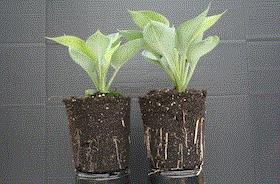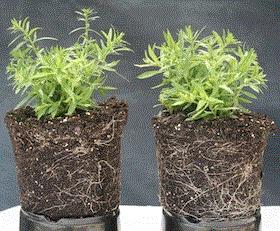Variability After Planting
The diagnostic challenge in the last newsletter was based on differences in crop appearance shortly after planting. Some plants appeared healthy, while others didn't. The reason for this appearance in the challenge was due to injury to the stems and roots of the plugs at the time of planting. Go HERE to read about the challenge and recommendations for removing plugs from the trays to alleviate this injury.
There are several other reasons crops may appear variable shortly after they're planted. Various sizes of plants within the plug tray, root pathogens present in the liners, dehydrated bareroot or bulbs, improper moisture levels at planting, incomplete vernalization, and improper planting depths are other common causes of crop variability.
Dealing With Crop Variability
If I was asked to narrow down the top three causes of crop variability this time of year, I'd say it's caused by unhealthy starting material, incomplete cold requirements and inadequate moisture levels at planting.
Unhealthy Starting Materials
The quality and health of starting materials is occasionally questionable or less than ideal. When this occurs, I most commonly observe variability in plant size within plug trays and/or poor root health due to root pathogens. When these factors are present, it’s incredibly challenging to produce uniform finished crops.
When there's variability or poor root health within the plug tray, first determine if the plants are viable and worth planting. Consider grading out the bad plants and only planting the good ones. If the root health is questionable, apply broad spectrum fungicides (such as
Empress Intrinsic or
Segway O tank mixed with
OHP 6672) to the plug trays before planting them.
Incomplete Cold Requirements
Many growers use dormant liners when planting in the late winter. In some instances, these crops may not begin to actively grow within weeks of being planted and placed into a warm environment. From my experience, this commonly occurs when the plants didn't receive enough hours of cold for them to overcome dormancy. Most perennials require a minimum of 1,000 hours of temperatures below 40F (5C) for them to overcome dormancy.
One trick I’ve learned for overcoming dormancy is to apply gibberellic acid using the PGRs
Fascination or
Fresco. I apply high volume applications using 3 ppm of product and applying 4.0 oz of solution per square foot of area being treated. A second application can be applied if the plants don’t respond within five days of the initial application. It doesn’t work on all plants and circumstances, but it sure is better than waiting several months for them to wake up on their own.
Moisture Levels at Planting
It should go without saying how important the role water has in the establishment of perennials in the early days after transplanting them. However, I’ve come across numerous instances over the years where I’ve observed the negative effects of improper moisture levels at the time of planting and the days that follow.
The biggest issue I’ve observed is inadequate moisture levels of the starting materials. I can’t emphasize enough how important it is to have well-watered starting materials just prior to planting them. It’s best to have plugs and liners nearly saturated at the time of planting.
The moisture level of the starting materials is more important than the moisture level of the growing mix they’re being planted into. A wet plug planted into dry soil establishes better than a dry plug planted into wet soil. This is especially true when the growing mix contains significantly larger-sized particles than those contained in the starter materials (like the bark mixes many perennial growers are using). It’s difficult to get water into a dry liner after it’s planted; this causes the plant to dry out further and become stressed, which leads to delayed establishment, crop variability and possibly even death.

It’s Time to "Empress" You
I mentioned Empress Intrinsic fungicide above ... Not only do I find it to be an effective fungicide, but I especially like using it in cases like those described above where there's crop variability in the early stages of a new crop. If you’re not already familiar, the active ingredient pyraclostrobin has been proven to help plants overcome various types of stresses (including transplant stress). Additionally, plants treated with pyraclostrobin often develop more roots than untreated plants. This is why Empress Intrinsic has become my preferred early season fungicide.
I performed several trials for BASF to demonstrate and verify the plant health benefits pyraclostrobin offers. Some of the trials looked at using pyraclostrobin after transplanting. Here are a couple of the trial results:
|

An Empress Intrinsic drench (3.0 fl. oz./100 gal.) was applied to Hosta Abiqua Drinking Gourd after planting. This image was taken 48 days following the application.
|

A spray application of Pageant Intrinsic (12 oz./100 gal.) was applied to the Aster Pink Magic after they were transplanted. These are the results just 27 days after the application.
|
In the majority of the trials, I observed slight to moderate increases in root mass (more roots in less time) compared to untreated plants. The increased rooting was observed on both plants treated before transplanting or when applications were made to them after transplanting.
Effective results were obtained when making spray applications of
Pageant Intrinsic (12.0 oz./100 gal.), drench applications of Pageant Intrinsic (12.0 oz. per 100 gal.) or
Empress Intrinsic (3.0 fl. oz. per 100 gal.).
These trials effectively demonstrated how pyraclostrobin could be applied to help plants overcome transplant stress and decrease the time for plants to begin rooting, as well as increasing the overall root mass.
Empress Intrinsic is the first fungicide I turn to when variability is observed or when root pathogens are suspected at or before the time the crops are planted. It makes perfect sense to not only apply an effective fungicide, but to use Empress Intrinsic to overcome early crop stresses. I hope these results "Empressed” you and perhaps Empress Intrinsic can be a valuable tool in your toolbox.

Navigating Through an ICE Visit
There’s never a good time for a visit from U.S. Immigration & Customs Enforcement (ICE). GrowerTalks editor Jen Zurko compiled some guidelines on how to handle a potential visit professionally and lawfully. Here ate the main points (in truncated form) she complied, but I encourage you to read them all (including more details than shown here) in her online article, "Steps on How to Handle ICE Visits."
-
Stay calm and professional
-
Do not grant immediate access
-
Know the difference in warrants
-
Know the difference between Inspections and Raids
-
Direct ICE to your HR manager or another designated company representative
-
Do not provide employee records without proper authorization
-
Ensure employee rights are protected
-
Communicate with employees
-
Contact legal counsel immediately
Keep in mind that these are just guidelines and not legal advice. Use them as a starting point, but don’t hesitate to contact your attorney if the need arises. Thank you, Jen, for compiling these guidelines.

California Spring Trials

The California Spring Trials, aka CAST, is just around the corner!
CAST 2025 is scheduled for March 25 - March 29, 2025. Unlike many trade events that are held at a single location, CAST is held at 10 separate locations spread across scenic central and northern California. I anticipate perennials will once again have a strong presence with new introductions from numerous companies, including Benary, Danziger, Darwin Perennials, Dümmen Orange, Green Fuse Botanicals, Kieft Seed, PlantHaven, Syngenta Flowers, ThinkPlants, Pacific Plug & Liner, and more.
Go
HERE to register for CAST.
Ball Publishing bobbleheads Chris Beytes, Jen Zurko, Bill Calkins and videographer Osvaldo Cuevas will be provide highlights from every location as they navigate through their road trip. Look for their coverage in the
Acres of buZZ! newsletter and on the
GrowerTalks YouTube channel.
My email is paul@opelgrowers.com if you have any comments, article suggestions or if you'd just like to say hello.
Best regards,

Paul Pilon
Editor-at-Large—Perennial Pulse
Director of Growing—Opel Growers
This email was received by you and 34,293 other fine subscribers!
If you're interested in advertising in Perennial Pulse, contact Kim Brown ASAP and she'll hook you up.